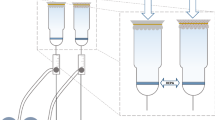Abstract
The pollution of the air and the monitoring of indoor air quality are receiving increasing attention worldwide, and many methodologies are now available to identify sources of pollution. However, there has been less work concerning the development of techniques to mitigate the effects of indoor air pollution. The aim of this study was to modify cotton fabrics with silver nanoparticles in order to use them in air conditioner filters. To achieve this goal, common fabrics purchased from commercial sources were evaluated in terms of their filtration properties (permeability, pressure drop, and collection efficiency) and were subsequently modified by impregnation with nanoparticles. This modification was achieved by immersion of the filters in nanoparticle suspensions. After drying the filter, collection of particulate matter was made in a toilet. The results showed that the filters impregnated with silver nanoparticles were able to significantly reduce the activity of microorganisms present in the airborne particulate matter, resulting in growth inhibition to the microorganisms which were retained (76.70%) and passed through (96.34%) the cotton filters.













Similar content being viewed by others
References
Catranis, C. M., Anagnost, S. E., Zhang, L., Zhou, S., Fernando, A., Morey, S., & Wang, C. J. K. (2006). A new sub-sampling method for analysis of air samples collected with the Andersen single-stage sampler. Aerobiologia, 22, 177–184.
Dullien, F. A. L. (1989). Introduction to industrial gas cleaning. San Diego: Academic Press.
Gioda, A., & Aquino Neto, F. R. (2003). Considerações sobre estudos de ambientes industriais e não-industriais no Brasil: uma abordagem comparativa. Caderno de Saúde Pública, 19(5), 1389–1397.
Guan, T., & Yao, M. (2010). Use of carbon nanotube filter in removing bioaerosols. Journal of Aerosol Science, 41, 611–620.
ISO 7708. (1995). Technical Committee ISO/TC 146: Air quality—particle size fraction definitions for health related sampling. Geneva: International Organization for standardization.
Lee, P. C., & Meisel, D. (1982). Adsorption and surface-enhanced Raman of dyes on silver and gold sols. Journal of Physical Chemistry, 86, 3391.
Lv, Y., Liu, H., Wang, Z., Liu, S., Hao, L., Sang, Y., Liu, D., Wang, J., & Boughton, R. I. (2009). Silver nanoparticle-decorated porous ceramic composite for water treatment. Journal of Membrane Science, 331, 50–56.
Park, J., Yoon, K., Kim, Y., Byeon, J. H., & Hwang, J. (2009). Removal of submicron aerosol particles and bioaerosols using carbon fiber ionizer assisted fibrous medium filter media. Journal of Mechanical Science and Technology, 23, 1846–1851.
Rai, M., Yadav, A., & Gade, A. (2009). Silver nanoparticles as a new generation of antimicrobials. Biotechnology Advances, 27, 76–83.
Seltzer, J. M. (1994). Biological contaminants. Journal of Allergy and Clinical Immunology, 94(2), 318–326.
Turkevich, J., Stevenson, P. C., & Hillier, J. (1951). Nucleation and growth process in the synthesis of colloidal gold. Discussions of the Faraday Society, 11, 55–75.
World Health Organization (WHO). (1989). Indoor air quality: organic pollutants. Report on a WHO Meeting. EURO Reports and Studies, (111), 1–70.
World Health Organization (WHO). (2006). Air quality guidelines: particulate matter, ozone, nitrogen dioxide and sulfur dioxide—global update 2005. Copenhagen: World Health Organization.
Yoon, K. Y., Byeon, J. H., Park, C. W., & Hwang, J. (2008). Antimicrobial effect of silver particles on bacterial contamination of activated carbon fibers. Environmental and Science & Technology, 42, 1251–1255.
Acknowledgements
The authors wish to thank CNPQ and FAPESP for financial support.
Author information
Authors and Affiliations
Corresponding author
Rights and permissions
About this article
Cite this article
de Freitas Rosa, P., Aguiar, M.L. & Bernardo, A. Modification of Cotton Fabrics with Silver Nanoparticles for Use in Conditioner Air to Minimize the Bioaerosol Concentration in Indoor Environments. Water Air Soil Pollut 228, 244 (2017). https://doi.org/10.1007/s11270-017-3429-y
Received:
Accepted:
Published:
DOI: https://doi.org/10.1007/s11270-017-3429-y




